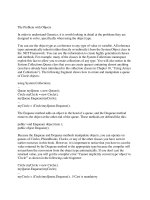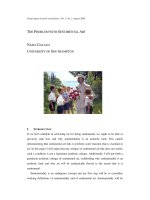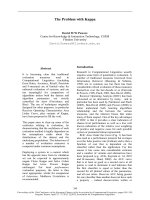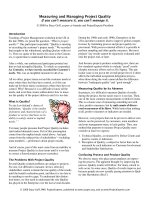The problem with Social Marketing Why you can’t sell change like soap ppt
Bạn đang xem bản rút gọn của tài liệu. Xem và tải ngay bản đầy đủ của tài liệu tại đây (185.42 KB, 13 trang )
mobile 0414 674 674 | | www.enablingchange.com.au
© Les Robinson 2009 1 www.enablingcange.com.au
The problem with Social Marketing
Why you can’t sell change like soap
If you work in health promotion or sustainability, you’ll have heard
of “Social Marketing” and “Community-based Social Marketing”.
1
I’ve noticed that these communication methodologies are
sometimes treated with almost magical reverence, as if they are the
long-awaited silver bullets for the complex social, health and
environmental problems we struggle with.
I believe many of the expectations placed on Social Marketing and
its variants are overblown and social change practitioners need to
be wary about claims made by their advocates.
Here’s why:
Of course you can market brands. But behaviour change is not like
buying a different brand of beer, it’s about getting people to DO
THINGS THEY ARE UNCOMFORTABLE WITH, DON’T WANT TO DO
OR CAN’T DO, or they would already be doing them. Like parents
letting their kids walk to school, or smokers quitting, or drivers
switching to public transport.
These kinds of social, health and environmental behaviours are
intractable because they are part of complex, “wicked” or messy
social problems. That’s why they are still with us. They are
intractable for very good reasons: they are fixed firmly in place by a
powerful matrix of institutional, technological and social factors. To
be effective change programs must therefore do more than just
communicate persuasive messages, they must aim to modify those
factors.
Paul Stern of the Division of Behavioral and Social Sciences and
Education of the UK’s National Research Council explains that many
behaviours are simply not amenable to voluntary change:
2
“This pattern of [contextual] influences implies that effective laws
and regulations, strong financial incentives or penalties, irresistible
© Les Robinson 2009 2 www.enablingcange.com.au
technology, powerful social norms, and the like can leave little room
for personal factors to affect behavior…”
In other words, when people have very little choice how they act,
structural changes (like regulation, pricing, infrastructure, service
provision, governance reform, social innovation, and technological
innovation) should be the preferred approaches.
He goes on to say that: “[however] when contextual influences are
weak, personal factors…are likely to be the strongest influence on
behavior.” However, if we are realistic, there are very few situations
where contextual factors are weak. Every personal decision is
thoroughly embedded in its context. Even a simple voluntary
behaviour like “turning off the lights” is determined by technology
and pricing.
The fact is, every effective social change effort has been
predominantly structural. Improving the anti-social behaviour of
drinkers, for instance, has required collaboration between police,
community leaders and licensing authorities; physical re-design of
venues; modified management practices; training for staff;
advocacy; political leadership; and legislative change. Marketing
has been the least important factor in the mix. Most solutions to
“wicked” problems are like this. They involve multi-faceted
strategies, and are very much about building relationships and re-
designing practices, places and institutions, with marketing often
taking an important support role.
Of course there’s nothing wrong with good marketing. It’s a vital
part of the mix. It spreads knowledge, creates interest, helps get
people buzzing, and helps spark political action so that politicians
get busy with the work of changing institutions and supporting
technological innovation. It is an important handmaiden of change,
but not the driver.
Let’s be clear what Social Marketing is
Social Marketing
3
is a way of planning communication programs
that aim to influence human behaviour. Community-based Social
Marketing
4
(CBSM) is a variant that includes influence techniques
drawn from social psychology. Communication for Behavioural
Impact
5
(COMBI) is another variant that’s been designed for aid
programs in developing countries.
One of the most commonly heard definitions of Social Marketing is:
© Les Robinson 2009 3 www.enablingcange.com.au
“Social Marketing is the application of commercial marketing
technologies to the analysis, planning, execution and evaluation of
programs designed to influence the voluntary behaviour of target
audiences to improve their personal welfare and that of society.”
6
The practice of Social Marketing (and CBSM and COMBI are very
similar) is said to consist of:
1) Start with a specific behavioural goal.
2) Conduct research with the target audience(s).
3) Be informed by psychological theories or models.
4) Tailor your efforts to suit the needs of the target audience(s).
5) Consider the 4 Ps: Product, Price, Place and Promotion.
6) Offer personal outcomes that the audience values.
7) Address the influence of competing promotions.
This reads like applied common sense. You wouldn’t want to design
a communication campaign any other way. Perhaps the excitement
that surrounds Social Marketing is partly due to what it replaced,
which was a complete lack of method in the design of health
promotion efforts. The problem with social marketing, however, is
that changing human behaviour involves a lot more a
communication campaign.
What’s the evidence for Social Marketing
As far as I can find, there has been only one systematic review of
Social Marketing practice.
7
This 2007 review, funded by the UK’s
National Social Marketing Centre, analysed the results of 54 Social
Marketing programs focusing on alcohol, tobacco, illicit drug use
and physical activity.
The researchers concluded, in part: “A majority of the [youth]
interventions…reported significant positive effects in the short term.
Effects tended to dissipate in the medium and longer term… These
results are broadly comparable with systematic reviews of other
types of substance use prevention interventions. The evidence is
more mixed for adult smoking cessation, although small numbers of
programs were nonetheless effective in this area.”
8
[my emphasis]
© Les Robinson 2009 4 www.enablingcange.com.au
In other words, these Social Marketing programs were found to be
about as effective as interventions not based on Social Marketing
methodology, which, I assume, means other kinds of educational
interventions.
Notably, 48 of these 54 programs relied substantially on face-to-
face tactics, like counselling and peer support, in addition to mass
media. The results therefore can’t be extrapolated to the great
majority of Social Marketing campaigns, which consist primarily of
mass media efforts. Since face-to-face interaction generally has far
greater personal impact than mass media communication, this
systematic review probably overstates the effectiveness of Social
Marketing.
So what does work?
Let’s take the three behavioural challenges which have a strong
emerging evidence base about what works and what doesn’t work:
tobacco cessation, road safety, and obesity prevention.
What reduces tobacco smoking?
According to a 2000 US National Cancer Institute study, media
campaigns can produce reductions in smoking, “but only when the
rest of the social structure actively changes the environment of the
smoker.”
9
A 2001 World Health Organisation review of anti-smoking
campaigns from 9 countries and 6 US states and concluded that
media campaigns can work when combined with counseling
services, price increases, advertising bans and indoor smoking
bans, and plenty of news stories.
10
A 2004 review concluded “substantial evidence indicates that higher
taxes and clean air laws can have a large impact on smoking rates.
Evidence also indicates that media campaigns when implemented
with other policies are important.”
11
What reduces road accidents?
The World Health Organisation’s 2004 "World Report on Traffic
Injury Prevention", an authoritative global review of road safety
interventions, does not mention Social Marketing, but notes “when
used in support of legislation and law enforcement, publicity and
information can create shared social norms for safety. However,
when used in isolation, education, information and publicity do not
generally deliver tangible and sustained reductions in deaths and
© Les Robinson 2009 5 www.enablingcange.com.au
serious injuries.”
12
A 2004 systematic review into the effectiveness of anti-drink-driving
programs concluded that mass media campaigns that are carefully
planned and well executed, that reach a sufficiently large audience,
and that are implemented together with other prevention activities
– such as highly-visible enforcement – are effective in reducing
alcohol-impaired driving and alcohol-related crashes.
13
Summarising the evidence, Woolley (2001)
14
concluded that mass
media advertising, when used alone, is unlikely to bring about
significant road user behaviour change. However, advertising was
found to play an important role in supporting other road safety
activities, in particular enforcement.
Barry Elliott, a Australian researcher who carried out a systematic
review of road safety campaigns, summed it up pithily: “you can’t
sell road safety like soap.”
15
What reduces obesity?
A recent US National Research Council report, Local Government
Actions to Prevent Obesity provided a nice summary of the kinds of
interventions that have the greatest potential to tackle childhood
obesity. According to the press release: “Many of these steps focus
on increasing access to healthy foods and opportunities for active
play and exercise. They include providing incentives to lure grocery
stores to underserved neighborhoods; eliminating outdoor ads for
high-calorie, low-nutrient foods and drinks near schools; requiring
calorie and other nutritional information on restaurant menus;
implementing local "Safe Routes to School" programs; regulating
minimum play space and time in child care programs; rerouting
buses or developing other transportation strategies that ensure
people can get to grocery stores; and using building codes to
ensure facilities have working water fountains.”
In other words, if we wanted to run a comprehensive anti-obesity
program then the skill mix would include an incentives manager, a
regulator, a building code planner, a nutritionist, a transport
planner, an educator (and a courageous politician or two to drive
these changes) but not a marketer.
So what, exactly, is wrong with social marketing?
Like most systems of practice or models, Social Marketing is good
at the things it pays attention to. The problem is the things it does
not pay attention to. In other words, it’s hidden assumptions:
© Les Robinson 2009 6 www.enablingcange.com.au
1) The behaviour is always right
Because Social Marketing is a model of practice not a theory of
behaviour it has no way of critically assessing the client’s
assumptions. Social Marketing almost invariably assumes the
clients’ prescribed behaviour or action is right, just, appropriate,
and do-able. As a result campaigns are often based around
remarkablely shallow and simplistic behavioural prescriptions. So
we have:
“Just think.” (the AFL’s anti-alcohol-violence campaign);
“Quit now before it’s too late” (Australian Government’s tobacco
campaign)
“Slow down stupid.” (Queensland’s anti-speeding campaign).
Social Marketing takes it as given that the particular behaviour
should be adopted and can be adopted. It does not ask whether the
prescribed behaviour make sense, whether it is capable of being
adopted or whether it needs to be reinvented, matured, debugged,
or replaced with an entirely different behaviour.
For instance, California’s anti-drug campaign has now abandoned
the typical “Just don’t do it” or “Talk to your kids” approaches and
opted for a far more subtle “Dinner makes the difference” approach,
where the behaviour is simply to have dinner with your kids. This
requires a fundamental re-think of the problem and the solution.
We simply do not see this in typical Social Marketing programs
where the funding agency’s assumptions reign supreme.
Incidentally, this is where the design profession is making a
tremendous contribution to social change efforts (see, for example,
MindLab, SILK, OpenIDEO and Low Carb Lane
16
). Design
thinking provides a systematic way to reinvent almost every aspect
of a change effort, including the prescribed behaviour itself, to
better fit peoples’ lives.
2) Context blindness
Because of its intense focus on the individual, Social Marketing
tends to neglect context. Context, as we discussed, is central to the
adoptability of behaviours. It’s more than a cursory consideration of
the 4 Ps: “product, price, place, promotion”. Instead the entire
© Les Robinson 2009 7 www.enablingcange.com.au
contextual system needs to be the subject of strategizing and
modification, including physical infrastructure, service design, place
design, management and regulatory systems. Getting these right is
usually what makes or breaks a change program, as we’ve seen in
tobacco control, road safety, pollution control and littering.
This work can only be done by multi-disciplinary teams using a
system-based approach. Silos tend to enforce dysfunction here, and
busting or bypassing silos is a prerequisite for effective systemic
interventions.
Again, it’s easy to see how design thinking can make a valuable
contribution to the mix.
By the way, this is not nearly as hard as it sounds. For a rapid
method for identifying doable interventions in a whole system, see
How to make a theory of change.
3) Crop spraying
Social Marketing, as almost universally understood and practiced, is
about efficiency: the most people reached at the least cost per
head. This inevitably leads to a focus on mass media advertising.
This approach treats people as isolated individuals and sprays them
from afar with messages the same way a crop duster sprays a crop
of canola. But who still thinks that human societies change this
way?
Fifty years of Diffusion of Innovations scholarship and more recent
social network studies (notably the remarkable work of Nicolas
Christakis and James Fowler on the diffusion of obesity, happiness
and smoking cessation through social networks) demonstrate that
decisions to adopt new behaviours travel primarily along social
networks of people who know and respect each other, on a wave of
conversations, and mass media has very little to do with it.
The programs that are likely to influence voluntary behaviour
change are therefore those based on fine-grained, conversational,
local approaches (like facilitated workshops, forums, field days and
the like). Unfortunately, the advertising agencies that win big
budget Social Marketing campaigns have no incentive to share this
insight with their funders.
4) Claim creep
What really changes the world, the message or the product?
© Les Robinson 2009 8 www.enablingcange.com.au
The “guru of marketing”, Philip Kotler, says “Good marketing is
about setting up expectations and fulfilling them…” This assumption
is continually reiterated in his thinking and it’s common in Social
Marketing too. You don’t have to think too deeply to realise this
claim is delusional. Marketing can set up expectations but it can’t
fulfill them. It’s products and behaviours that fulfill, or fail to fulfill,
expectations. And it’s scientists and technical experts who design
those products or behaviours, whether they’re health boffins or
agricultural scientists or whatever. Good marketing is always the
last link in a long chain of professional efforts, not the whole story.
5) Theory fetish
It’s a fine thing to have our thinking expanded by psychological and
change theories, but it’s another thing to arbitrarily impose a
particular psychological theory on real people leading complicated
lives in the real world. It’s quite common to see social marketing
and health promotion programs introduced with a statement that
“this program is based on the Transtheoretical Model” or the Health
Belief Model or Social Learning Theory, or whatever. Excuse me, but
this is crazy. The theory of change that informs a program should
come from one place only – the reality of people’s lives, and it will
be very different for every set and every setting and every moment
in time. Generic theories and models can help us think better as
change agents, but only by getting to know people face-to-face and
listening intently to their stories can we begin to construct solutions
to their needs.
Even Craig Lefebvre, an ardent defender of Social Marketing, is
clear on this when he writes that “One principle that distinguishes
the best social marketers, I believe, is an unrelenting
understanding, empathy and advocacy of the perspective of our
priority population or community that is not slanted by what the
theory or research evidence does or does not tell us.”
17
6) Power blindness
Social Marketing campaigns tend to be one-sided exercises in power
by government-employed professionals who decide what behaviours
are wrong, what behaviours are right, who needs to change, and
what they need to know. Only problem is: people HATE being given
advice by strangers about how they should behave. Social
Marketing doesn’t even begin to have answers for the waves of
denial and resistance that are evoked by well meaning attempts to
tell people how they should live their lives. See, for instance, the
literature on psychological reactance
18
and the Boomerang Effect.
19
© Les Robinson 2009 9 www.enablingcange.com.au
Social Marketing programs have figured out a way to remain
oblivious to denial and resistance: they prefer to evaluate their
efforts at the level of awareness rather than behaviour. Awareness,
however, cuts both ways. Awareness may help drive change, but it
is just as implicated in driving people to do the opposite to what
they are told. There’s plenty of evidence, for instance, that
marketing efforts may reinforce good behaviour amongst those who
are already doing the right thing, but drive greater denial and/or
resistance amongst the actual target audience.
20
Even a seemingly
benign effort like asking householders to calculate their ecological
footprints has been shown to produce this effect.
21
7) Individual focus
The focus of Social Marketing campaigns is the atomised individual.
Yet community organisation is one really effective method of
achieving change. When change comes from a community’s own
collective efforts it is likely to be more appropriate, more credible,
and more sustained than when it comes from government.
If a teeny fraction of the giant Social Marketing media budgets was
spent on supporting people to organise and empower themselves to
care for their own health, environments and communities I think we
would witness far more deep and abiding change than through any
conceivable marketing campaign.
8) Message Fetish
Lastly, Social Marketing has message fetish embedded deep in its
genomes. Marketing has always been an art of mass
communication. It is concerned, above all else, with language and
image. It will always be, for better or worse, about the magic of the
message. It’s hopelessly infected with the assumption that the right
form of words is the key to the human psyche. If it was that easy
we’d all long ago have been living in paradise (or, more likely, hell).
It just ain’t that way.
And my point is…
I don’t discount the utility of Social Marketing, CBSM and COMBI as
communication practices, but as social change practices they fall
short. The halo of omnipotence that accompanies them is
unwarranted. They are a valuable support practices, not the
messiah.
© Les Robinson 2009 10 www.enablingcange.com.au
There is nothing wrong with marketers being involved in designing
change programs. They bring vital skills and perspectives. In fact a
change program that doesn’t involve marketers is probably only
slightly less ridiculous than one that is run entirely by marketers.
However, the ability to change the world will never be the shining
glory of any one discipline. Successful change efforts happen when
engineers, planners, designers, politicians, regulators, facilitators
and marketers step out of their cosy professional fugs, mix it up
with each other, let their assumptions be challenged, be prepared
to defend those assumptions with evidence, and invite the public to
genuinely collaborate in this process. That’s when the shining glory
begins.
If not Social Marketing, then what? I don’t think the alternative is
rocket science, just a little confronting for those who prefer life in a
silo.
1) Get the “who” right first. Bypass silos, work in multi-
disciplinary teams, and invite the users to share the big decisions
with you.
2) Get inspired by what works elsewhere. Don’t start till you’ve
got lost in Google and Google Scholar a few times and been
genuinely excited by the methods others have used, no matter how
unfamiliar.
3) Listen to users and non-users and don’t stop listening till
you’ve been startled or confronted by what you hear.
4) Notice your own power and actively share it around,
especially with those whose behaviour you hope to change.
5) Think in terms of systems. Map the system and don’t limit
your palette of interventions.
6) Get all those who can make a difference around the table
before you start planning. Let them share the thinking, the
planning and the credit.
7) Intervene in the context. Act to modify the social,
technological and physical environments in which people make their
decisions and then use communications to draw peoples’ attention
to those changes and model appropriate behaviours.
© Les Robinson 2009 11 www.enablingcange.com.au
8) Be ready to abandon your own assumptions, even the ones
you don’t know you have. Instead, innovate like crazy, treat every
idea as provisional and every tactic as an experiment.
What might this approach be called? I suggest simply Multi-
Disciplinary Change Practice.
22
What would an effective process for Multi-Disciplinary Change
Practice look like? I’m done my best to evolve one over the last few
years. It’s available on my website, see The Enabling Change
process.
v4.1 June 2011 (first written 2009)
Considering that Social Marketing thrives in academia, supposedly
the place of critical inquiry, critiques of social marketing are
surprisingly thin on the ground.
For another critique of Social Marketing, see:
Tilbury, D., Coleman, V., Jones, A., MacMaster, K. (2005) A
National Review of Environmental Education and its Contribution to
Sustainability in Australia: Community Education. Canberra:
Australian Government Department for the Environment and
Heritage and Australian Research Institute in Education for
Sustainability (ARIES), pp17
/>/Volume3_Revised05.pdf
© Les Robinson 2009 12 www.enablingcange.com.au
1
Social Marketing appears to be especially dominant in marketing academies in
universities and the government health departments they advise and often work for.
See, for example, the program of the biennial World Social Marketing Conference,
Meanwhile Community-based Social Marketing has been exclusively applied in the
environmental sustainability field.
COMBI, by comparison, does not seem to have made big inroads in the overseas
aid field. Aid agencies appear to have resisted marketing-based solutions: for
example see Kyama, R. and McNeil, D.G. Distribution of Nets Splits Malaria
Fighters, New York Times, Oct 9 2007. Here an Social Marketing-based program
for distributing malaria-impregnated nets in Kenya in was rejected by the World
Health Organisation because it involved selling nets for $1 to $2.50 through local
shops. In fact massive free giveaways were far more effective in ensuring broad
adoption.
/>ed=print
2
Paul C. Stern (2005) Individuals’ Environmentally Significant Behaviour,
Environmental Law Reporter News and Analysis 35 10785
/>20PDF.pdf
3
For a clear expression of rigorous Social Marketing practice you probably can’t
do better than the work of Craig Lefebvre of The George Washington University
School of Public Health and Health Services. He has a thoughtful and well
informed blog, of which this summary of his social marketing practice is typical.
/>social-marketing-program.html
4
Dr Doug McKenzie-Mohr’s popular Community-Based Social Marketing (CBSM) is
a variation of Social Marketing that brings in techniques drawn from the social
psychology of selling (especially via the work of Robert Cialdini).
5
For COMBI, see, for instance:
6
Andreason, A. (1995) Marketing Social Change: Changing Behaviours to
Promote Health, Social Development, and the Environment, Jossey-Bass, San
Francisco, p7
7
Stead, M. Gordon, R. Angus, K. and McDermott, L. (2007) A systematic review
of social marketing effectiveness, Health Education 107(2) pp126-191
/>me=html/Output/Published/EmeraldFullTextArticle/Pdf/1421070203.pdf
8
p180. Oddly only six of the 54 programs relied entirely on typical marketing
methods, the rest included methods that no one would define as marketing,
including counselling, smoking cessation groups, community organization, peer
education, classroom lessons, training, citizen taskforces, buddy support, summer
camps, exercise classes, and construction of walking paths. Only two, however,
used any structural or regulatory methods, which is the point.
9
National Cancer Institute (2000) Population Based Smoking Cessation:
Proceedings of a Conference on What Works to Influence Cessation in the General
Population, Smoking and Tobacco Control Monograph No 12, Bethesda, MD, US
Department of Health and Human Services, p200
10
Schar, E.H., and Gutierrez, K.K. (2001) Smoking Cessation Media Campaigns
From Around the World, Recommendations From Lessons Learned, World Health
Organisation, Copenhagen
© Les Robinson 2009 13 www.enablingcange.com.au
11
David T. Levy, Frank Chaloupka, and Joseph Gitchell (2004) The Effects of
Tobacco Control Policies on Smoking Rates: A Tobacco Control Scorecard, Journal
of Public Health Management Practice, 2004, 10(4), 338–353
12
Peden, M. et al (eds) (2004) The World Report on Traffic Injury Prevention,
World Health Organisation, p138
13
Elder R.W. et al (2004) Effectiveness of mass media campaigns for reducing
drinking and driving and alcohol-involved crashes: a systematic review. American
Journal of Preventive Medicine 27(1) p57-65
14
Motor Accident Commission (2001) Road Crash Facts for South Australia,
Government of South Australia.
15
Elliott, B. (1993) Road Safety Mass Media Campaigns: A Meta Analysis,
Department Of Transport And Communications, Federal Office Of Road Safety
16
MindLab
SILK
OpenIDEO
Low Carb Lane www.dott07.com/go/lowcarblane
17
/>social-marketing-wrong-in-health-behavior-and-health-education.html
18
“when a communicator tells his audience what conclusion they must draw,
there is a significant resistance to attitude change and even a tendency for
boomerang attitude change.” Brehm, J.W. (1966) A Theory of Psychological
Reactance, Academic Press, New York 121
19
Ringold, J.R. (2002) Boomerang Effect: In response to public health
interventions: Some unintended consequences in the alcoholic beverage market,
Journal of Consumer Policy 25 p34-35
20
For instance, Leffingwell T.D. et al (2007) Defensively biased responding to risk
information among alcohol-using college students, Addictive Behaviours 32
pp158-165
21
Brook, A.T., (2011). Ecological footprint feedback: Motivating or discouraging?
Social influence 9 p113-128
22
For a definition of Multi-Disciplinary see the Wikipedia entry for Inter-
disciplinary (which means the exactly same thing).









